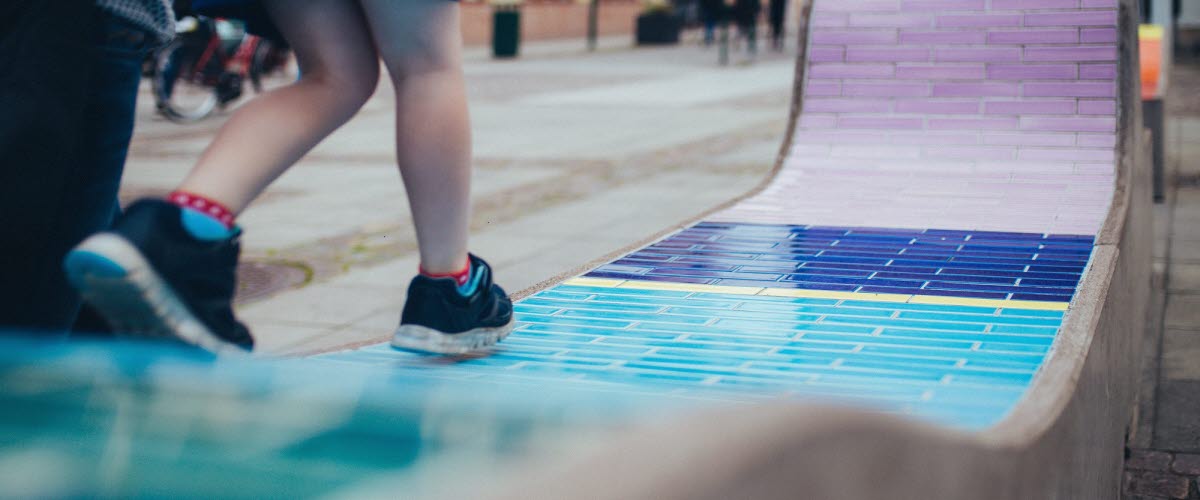Porcelain and architecture in Lidköping
Swedish design is known for its clean lines, often taking inspiration from nature. You can find a perfect example of this if you visit the Naturum Visitor Centre Victoriahuset beside Läckö Castle, close to Lidköping on the southern shores of Lake Vänern. In the picturesque town centre you can also discover the story of Rörstrand porcelain, which won the hearts of the Swedish people with its timeless style.
Not only is there a café on almost every corner – art and design form a natural part of Lidköping. When the new pedestrian zone was created in 2011 local residents got to make their mark on the town by creating paintings that were then transferred to tiles to be set into the street. Porcelain elements can also be seen in Nya Stadens torg (which incidentally is the biggest open square in northern Europe) in the form of decorations by designer Anna Elzer Oscarson and artist Astrid Sylwan.
Porcelain for commoners and Nobel banquets alike
Many people associate Rörstrand porcelain with nostalgic memories of coffee breaks on sunny summer days at their grandparents’. Both their popular everyday tableware and exclusive fine porcelain pieces have an obvious place in design history. The intense blue flowers on Marianne Westman’s Mon Amie range are highly recognisable. As is the stylish Swedish Grace service, with its discreet depictions of ears of wheat, designed by Louise Adelborg, which has achieved cult status in Swedish homes. Rörstrand is Europe’s second oldest porcelain brand and has influenced perceptions of Swedish design since it was founded in 1726. Did you know, for example, that the Nobel Banquet is served on Rörstrand porcelain every year?
Let your creativity flow at Rörstrand Center
In the heart of Lidköping you will find Rörstrand Center – a creative hotspot with a pottery school, museum, designer shops, restaurant and café. A tour of Rörstrands Museum will take you through more than 290 years of Swedish porcelain history. Learn about how this ‘white gold’ was manufactured at Europe’s oldest porcelain factories, and be inspired by both everyday items and stylish showpieces. Don’t miss out on visiting the creative workshop (Skaparverkstaden), where you can try your hand at turning, sculpting with clay or painting your own mug. Rörstrand’s classic industrial premises are also home to Formakademin – a knowledge centre training the ceramic artists, modellers and pattern designers of today.
Anna Elzer Oscarson – keeping tradition alive
Rörstrand Center also houses what is possibly Sweden’s smallest porcelain factory – Porslinsfabriken i Lidköping – which is keeping the tradition alive now that large-scale production has moved overseas. Through close collaboration with modern designers such as Anna Elzer Oscarson, contemporary ceramics are being produced in this traditional
setting. Her Dancing Dune collection offers a playful, streamlined range in earthy shades. Porslinsfabriken also serves as the production site for Svenskt Tenn’s beautifully timeless pots and, since 2007, Hackefors Porslin, elegant tableware that has been bringing a touch of extra luxury to Swedish design for almost one hundred years.
Modern architecture in a natural setting
When visiting Lidköping, a trip out to Kållandsö, just north of the town, is a must. Here you will find another chapter in Sweden’s design history. Architectural firm White has taken inspiration from the slender reeds and raw driftwood of the Lake Vänern archipelago to create the attractive Victoriahuset visitor centre, with a variegated ribbed wooden façade that helps it blend into its surroundings. It provides a striking example of how Swedish architecture draws inspiration from its immediate surroundings. The building is named after the Duchess of Västergötland – H.R.H. Crown Princess Victoria – who received it as a symbolic 30th birthday gift from the Västra Götaland region in 2007. The nature-inspired façade design is also echoed inside the building. Inside you will find Naturum Visitor Centre Vänerskärgården, a restaurant callled Gastrosfär and a hotel.
Outside Naturum Visitor Centre you can view Europe’s largest freshwater archipelago with its 22,000 or so islands, islets and skerries. The best way to explore the beautiful Vänerskärgården archipelago is by kayak, but there are also several attractive hiking trails. Discover the rich bird life of Kållandsö island along lakeside meadows, rocky shorelines and a varied cultural landscape with petroglyphs from the Bronze Age. To the east, the distant plateau mountain of Kinnekulle is glimpsed on the horizon.
The fairytale castle of Läckö
While Victoriahuset may have been specially designed to blend in with nature, the exact opposite is true of Läckö Castle, which stands proudly at the furthest tip of a rocky peninsula beside Lake Vänern. Count and Chancellor Magnus Gabriel de la Gardie gave the building its characteristic white Baroque charm during the second half of the 17th century. The castle, with its numerous towers, is like something straight out of a fairytale, and in summer people from around the world make a pilgrimage to Läckö to enjoy top-class opera in the setting of the large castle courtyard with its wonderful acoustics.
Discover the green treasure of the Small Castle Garden
On the east side of Läckö Castle lies the Small Castle Garden, tended by gardener Simon Irvine and his team. Every spring the soil is turned by hand, carefully and methodically. And every autumn, compost heaps are created under the walnut trees. We take care to make use of everything. If you would like to know more about what grows here, Simon and his colleagues are almost always around and happy to take time to chat to visitors about the garden.
During its heyday, Rörstrand employed Sweden’s foremost designers for the porcelain factory in Lidköping. The museum houses both themed and collection displays.



